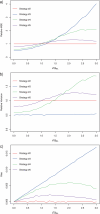Double Sampling for Informatively Missing Data in Electronic Health Record-Based Comparative Effectiveness Research
- PMID: 39638313
- PMCID: PMC11639654
- DOI: 10.1002/sim.10298
Double Sampling for Informatively Missing Data in Electronic Health Record-Based Comparative Effectiveness Research
Abstract
Missing data arise in most applied settings and are ubiquitous in electronic health records (EHR). When data are missing not at random (MNAR) with respect to measured covariates, sensitivity analyses are often considered. These solutions, however, are often unsatisfying in that they are not guaranteed to yield actionable conclusions. Motivated by an EHR-based study of long-term outcomes following bariatric surgery, we consider the use of double sampling as a means to mitigate MNAR outcome data when the statistical goals are estimation and inference regarding causal effects. We describe assumptions that are sufficient for the identification of the joint distribution of confounders, treatment, and outcome under this design. Additionally, we derive efficient and robust estimators of the average causal treatment effect under a nonparametric model and under a model assuming outcomes were, in fact, initially missing at random (MAR). We compare these in simulations to an approach that adaptively estimates based on evidence of violation of the MAR assumption. Finally, we also show that the proposed double sampling design can be extended to handle arbitrary coarsening mechanisms, and derive nonparametric efficient estimators of any smooth full data functional.
Keywords: causal inference; double sampling; missing data; semiparametric theory; study design.
© 2024 The Author(s). Statistics in Medicine published by John Wiley & Sons Ltd.
Conflict of interest statement
The authors declare no conflicts of interest.
Figures




References
-
- Seaman S. R. and White I. R., “Review of Inverse Probability Weighting for Dealing With Missing Data,” Statistical Methods in Medical Research 22, no. 3 (2013): 278–295. - PubMed
-
- Rubin D. B., Multiple Imputation for Nonresponse in Surveys (Hoboken, NJ: John Wiley & Sons, 2004).
-
- Robins J. M., Rotnitzky A., and Zhao L. P., “Estimation of Regression Coefficients When Some Regressors Are Not Always Observed,” Journal of the American Statistical Association 89, no. 427 (1994): 846–866.
-
- Tsiatis A., Semiparametric Theory and Missing Data (New York, NY: Springer, 2007).
-
- Rubin D. B., “Inference and Missing Data,” Biometrika 63, no. 3 (1976): 581–592.
MeSH terms
Grants and funding
LinkOut - more resources
Full Text Sources
Miscellaneous
